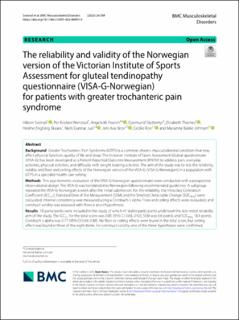| dc.description.abstract | Background Greater Trochanteric Pain Syndrome (GTPS) is a common chronic musculoskeletal condition that may affect physical function, quality of life and sleep. The Victorian Institute of Sport Assessment-Gluteal questionnaire (VISA-G) has been developed as a Patient-Reported Outcome Measurement (PROM) to address pain, everyday activities, physical activities, and difficulty with weight bearing activities. The aim of the study was to test the reliability, validity and floor and ceiling effects of the Norwegian version of the VISA-G (VISA-G-Norwegian) in a population with GTPS in a specialist health care setting.
Methods This psychometric evaluation of the VISA-G-Norwegian questionnaire were conducted with a prospective observational design. The VISA-G was translated into Norwegian following recommended guidelines. A subgroup repeated the VISA-G-Norwegian a week after the initial submission. For the reliability, the Intraclass Correlation Coefficient (ICC2.1), Standard Error of the Measurement (SEM) and the Smallest Detectable Change (SDC95%) were calculated. Internal consistency was measured using a Cronbach ́s alpha. Floor and ceiling effects were evaluated, and construct validity was assessed with three a priori hypotheses.
Results 78 participants were included in the study of which 47 stable participants undertook the test-retest reliability arm of the study. The ICC2.1 for the total score was 0.85 (95% CI 0.68, 0.92), SEM was 6.6 points and SDC95% 18.4 points. Cronbach`s alpha was 0.77 (95% CI 0.69, 0.84). No floor or ceiling effects were found in the total score, but ceiling effect was found in three of the eight items. For construct validity, one of the three hypotheses were confirmed.
VISA-G-Norwegian correlated to the modified Harris Hip Score (mHHS), Oswestry Disability Questionnaire (ODI) and Numeric Pain Rating Scale (NPRS), 0.64, -0.75 and − 0.63 respectively.
Conclusion The VISA-G-Norwegian has acceptable reliability and validity, despite ceiling effect of individual items. The large SDC95% should be considered when measuring change in similar cohorts with GTPS. For a potential future version, it would be recommended to consider response options for questions with ceiling effect and the comprehensibility of question eight. | en_US |

